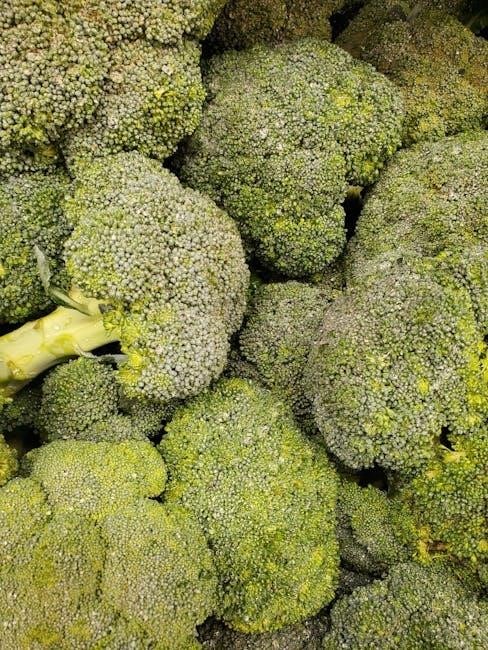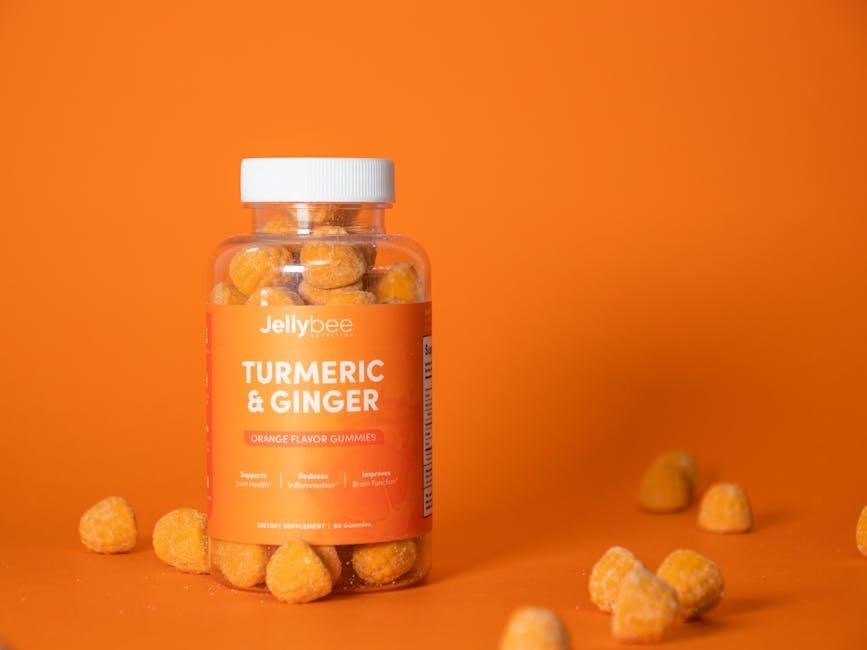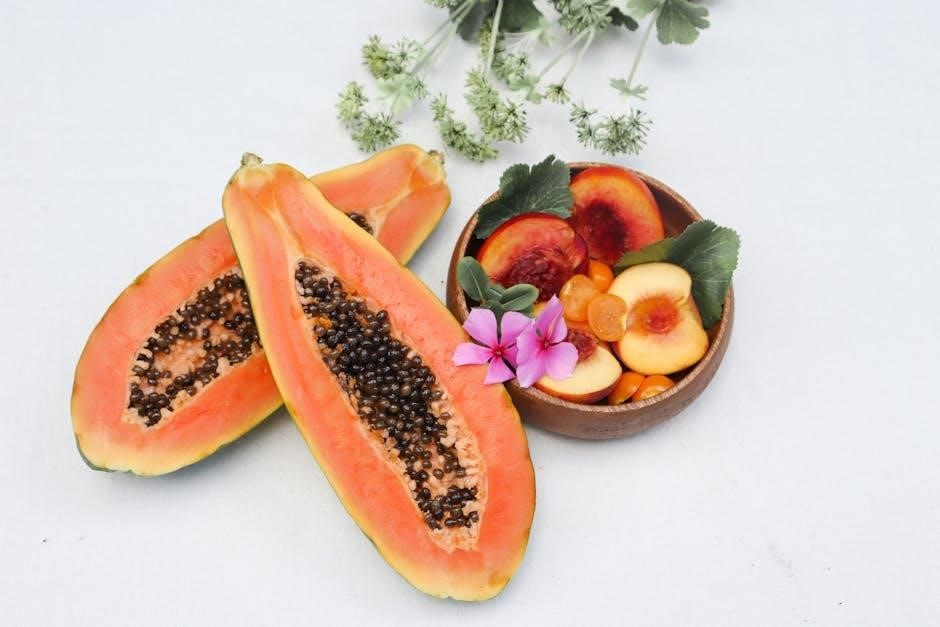The low histamine anti-inflammatory diet is tailored to manage histamine intolerance and reduce inflammation. It focuses on fresh, non-fermented foods and avoids high-histamine triggers, promoting overall well-being and symptom relief.
Understanding Histamine Intolerance and Inflammation
Histamine intolerance occurs when the body cannot effectively break down histamine due to enzyme deficiencies, leading to symptoms like allergies, digestive issues, and skin rashes. Chronic inflammation, often triggered by high histamine levels, can worsen conditions like asthma and eczema. Reducing histamine intake and adopting anti-inflammatory strategies helps alleviate symptoms and improve overall health, addressing the root causes of these interconnected issues.
Importance of Combining Histamine Reduction with Anti-Inflammatory Strategies
Combining histamine reduction with anti-inflammatory strategies addresses both symptom relief and root causes. Histamine triggers inflammation, worsening conditions like allergies and chronic inflammation. By lowering histamine intake and focusing on anti-inflammatory foods, individuals can reduce inflammation, alleviate symptoms, and improve overall health. This dual approach is essential for managing histamine intolerance and preventing long-term health complications effectively.
Key Principles of a Low Histamine Diet
Avoid high-histamine foods like fermented items, aged meats, and certain fish. Focus on fresh, non-fermented foods, antioxidants, and staying hydrated to manage histamine levels effectively.
Foods to Avoid: High Histamine Food List
Avoid fermented foods like sauerkraut, kimchi, and soy sauce, as they contain high histamine levels. aged cheeses, processed meats, and canned fish are also problematic. Citrus fruits, tomatoes, and eggplant can trigger histamine release. Alcohol, especially wine and beer, should be avoided. Fresh meat and fish should be consumed within a day of purchase to minimize histamine buildup. These foods can exacerbate symptoms in sensitive individuals.
Foods to Emphasize: Fresh, Non-Fermented, and Histamine-Lowering Options
Focus on fresh vegetables like leafy greens, cucumbers, and bell peppers. Incorporate fresh fruits such as apples, pears, and bananas, which are low in histamine. Lean meats like chicken and turkey, and wild-caught fish like salmon, are ideal. Include non-dairy milks like almond and coconut. Herbs like parsley and basil add flavor without histamine. These foods help stabilize histamine levels and reduce inflammation, promoting a balanced diet.
Anti-Inflammatory Diet Basics
An anti-inflammatory diet focuses on antioxidant-rich foods, omega-3 fatty acids, and whole, unprocessed ingredients to reduce inflammation and promote overall health. It avoids processed foods and sugars, which can trigger inflammation. This approach supports chronic disease prevention and enhances well-being by addressing the root causes of inflammation in the body.
Foods That Reduce Inflammation: Focus on Antioxidants and Omega-3s
Foods rich in antioxidants, such as berries, leafy greens, and nuts, help neutralize free radicals that cause inflammation. Omega-3 fatty acids, found in wild fish like salmon and mackerel, reduce inflammation by balancing eicosanoids. Incorporating olive oil, seeds, and whole grains further supports anti-inflammatory effects. These foods work synergistically to promote healing and protect against chronic diseases, making them essential components of an anti-inflammatory diet.
Lifestyle Factors Influencing Inflammation: Stress, Sleep, and Exercise
Chronic stress triggers inflammation by dysregulating cortisol levels. Prioritizing stress management through meditation or yoga can mitigate this. Adequate sleep is essential for immune regulation, with 7-9 hours nightly recommended. Regular exercise, such as walking or swimming, reduces inflammation without overexertion. Balancing these lifestyle factors supports anti-inflammatory efforts and enhances the effectiveness of dietary changes, promoting overall health and resilience.
Combining Low Histamine and Anti-Inflammatory Diets
This approach focuses on fresh, non-fermented foods, avoiding histamine triggers, and incorporating anti-inflammatory nutrients. It reduces inflammation and alleviates histamine intolerance symptoms effectively when followed consistently.
How Histamine and Inflammation Are Interconnected
Histamine, a neurotransmitter and immune system mediator, can trigger inflammation when levels are elevated. High histamine foods and impaired DAO enzyme function often lead to inflammation, worsening symptoms like allergies and skin issues. Reducing histamine intake and addressing inflammation through diet can alleviate these conditions, showcasing their interconnected role in overall health and well-being.
Strategies to Simultaneously Lower Histamine and Reduce Inflammation
Adopting a low histamine diet alongside anti-inflammatory practices is key. Eliminate aged, fermented, and processed foods while emphasizing fresh vegetables, lean meats, and wild fish. Incorporate vitamin C-rich foods to aid histamine breakdown and anti-inflammatory compounds like omega-3s. Avoid stress triggers and ensure proper hydration to support detoxification. Balancing these approaches can effectively lower histamine levels and reduce inflammation for improved health outcomes.
Health Benefits of the Combined Approach
The low histamine anti-inflammatory diet reduces histamine intolerance symptoms and chronic inflammation, improving digestion, skin health, and energy levels while promoting long-term well-being and resilience.
Alleviating Symptoms of Histamine Intolerance
A low histamine anti-inflammatory diet can significantly reduce symptoms of histamine intolerance, such as allergic reactions, digestive issues, skin rashes, and respiratory discomfort. By eliminating high-histamine foods and focusing on fresh, non-fermented options, individuals often experience improved digestion, clearer skin, and reduced inflammation. This approach also helps stabilize histamine levels, minimizing reactions like hives, itching, and breathing difficulties, leading to enhanced overall well-being and resilience.
Reducing Chronic Inflammation and Improving Overall Health
The low histamine anti-inflammatory diet focuses on antioxidants and omega-3s to combat chronic inflammation, promoting healing and vitality. By avoiding fermented and processed foods, it reduces inflammatory triggers, enhancing digestion and immune function. This approach improves overall health, lowering the risk of chronic diseases and improving well-being naturally.
Common Challenges and Solutions
Navigating the low histamine diet can be challenging due to limited food options and social pressures. Meal prepping and seeking professional guidance can help overcome these obstacles effectively.
Navigating Social and Practical Challenges of the Diet
Adhering to a low histamine diet can be socially and practically challenging. Meal prepping and clear communication about dietary needs can ease social pressures. Fresh, non-fermented foods require careful shopping and preparation. Reading labels to avoid hidden histamine triggers is essential. Planning meals in advance and seeking support from others can help maintain consistency and reduce stress. Proper planning ensures access to safe, nutritious food while managing histamine and inflammation effectively.
Addressing Nutritional Deficiencies and Ensuring Adequate Nutrition
A low histamine diet may require careful planning to prevent nutritional deficiencies. Key nutrients like vitamin C, B12, and omega-3s are crucial for histamine regulation. Incorporating fresh vegetables, lean meats, and wild fish helps maintain essential nutrients. Supplements, such as vitamin C, can support histamine breakdown. Consulting a dietitian ensures a balanced intake, addressing potential gaps and optimizing overall nutrition while adhering to dietary restrictions.

Low Histamine Anti-Inflammatory Food List
The diet emphasizes fresh vegetables, lean meats, and wild fish, while avoiding fermented, processed, and high-histamine foods to minimize inflammation and histamine-related symptoms effectively.
Best Foods to Include: Fresh Vegetables, Lean Meats, and Wild Fish
Fresh vegetables like leafy greens, cucumbers, and bell peppers are ideal, as they are low in histamine and rich in antioxidants. Lean meats such as chicken and turkey, and wild fish like salmon and cod, are excellent choices due to their anti-inflammatory properties. These foods help reduce histamine levels and inflammation, promoting overall health and symptom relief for those with histamine intolerance.
Foods to Avoid: Fermented, Processed, and High-Histamine Items
Fermented foods like sauerkraut, kimchi, and aged cheeses are high in histamine and should be avoided. Processed meats, such as salami and ham, and high-histamine foods like citrus fruits and tomatoes, can trigger symptoms. Avoiding these items helps reduce histamine intake and minimizes inflammation, which is crucial for managing histamine intolerance and achieving better overall health through dietary adjustments.

Meal Planning and Recipes
Plan meals with fresh, low-histamine ingredients like vegetables, lean meats, and wild fish. Simple recipes include grilled chicken salads and stir-fries, ensuring balanced nutrition and ease of preparation.
Creating Balanced and Nutritious Meals
Emphasize fresh vegetables, lean meats, and wild fish to ensure balanced nutrition. Avoid fermented and high-histamine foods. Incorporate antioxidants and omega-3s to reduce inflammation. Plan meals to prevent hunger, ensuring a variety of flavors and textures. Consult a dietitian for personalized guidance to meet nutritional needs while managing histamine levels and inflammation effectively.
Simple and Delicious Recipe Ideas for Everyday Cooking
Focus on fresh, histamine-friendly ingredients like grilled wild-caught fish, fresh vegetable stir-fries, and lean meats. Try recipes like roasted chicken with herbs, quinoa salads with fresh greens, or steamed vegetables with olive oil. Avoid fermented condiments and opt for natural flavor enhancers like lemon juice or garlic. These meals are easy, nutritious, and align with anti-inflammatory principles, ensuring both taste and health benefits.

Additional Tips for Success
Always read food labels to identify hidden histamine triggers. Stay hydrated to support natural detoxification processes and histamine management, ensuring long-term success on the diet.
Importance of Reading Labels and Avoiding Hidden Histamine Triggers
Reading food labels is crucial to identify hidden histamine triggers, such as additives, preservatives, and fermented ingredients. Many processed foods contain histamine or histamine-releasing compounds, even if not explicitly stated. Always check for terms like “hydrolyzed protein” or “yeast extract,” which can elevate histamine levels. Being vigilant helps avoid unintended exposure and ensures adherence to the low histamine diet, promoting better symptom management and overall health.
Staying Hydrated and Managing Histamine Through Detoxification
Staying hydrated is essential for flushing out excess histamine and supporting detoxification pathways. Drinking plenty of water helps the liver and kidneys process and eliminate histamine effectively. Additionally, vitamin C-rich foods aid in breaking down histamine, while electrolytes maintain fluid balance. Proper hydration enhances the body’s natural detox mechanisms, reducing histamine buildup and alleviating symptoms. Prioritize water intake and consider incorporating herbal teas to support overall detoxification and histamine management.

Consulting Healthcare Professionals
Consulting healthcare professionals, such as dietitians and doctors, is crucial for personalized guidance on managing histamine intolerance and inflammation through tailored dietary and lifestyle adjustments.
Role of Dietitians and Doctors in Tailoring the Diet
Dietitians and doctors play a vital role in creating personalized low histamine anti-inflammatory diets. They assess individual needs, identify high-histamine triggers, and recommend nutrient-rich alternatives. Professionals also monitor progress, address deficiencies, and adjust plans to optimize symptom relief and long-term health outcomes. Their expertise ensures a balanced and sustainable approach to managing histamine intolerance and inflammation effectively.
When to Seek Professional Guidance for Histamine Intolerance
Seek professional guidance if symptoms persist despite dietary changes or worsen over time. Consult a dietitian or doctor for personalized advice, especially if managing coexisting conditions. They can help identify triggers, monitor progress, and ensure nutritional adequacy. Professional guidance is crucial for developing a tailored plan and addressing underlying issues, ensuring effective long-term histamine and inflammation management.
The low histamine anti-inflammatory diet offers long-term health benefits, reducing symptoms and inflammation. Sustainable and tailored, it promotes overall well-being, empowering individuals to manage histamine intolerance effectively.
Long-Term Benefits and Sustainability of the Diet
The low histamine anti-inflammatory diet provides lasting relief from intolerance symptoms and reduces chronic inflammation. By focusing on fresh, nutrient-rich foods, it supports immune health and digestion. Sustainability is achieved through balanced meal planning and mindful eating, ensuring long-term adherence. This approach not only alleviates immediate discomfort but also promotes overall well-being and disease prevention. Consistency is key to maintaining its benefits.
Motivation and Next Steps for Implementing the Low Histamine Anti-Inflammatory Diet
Embrace the diet with confidence, knowing it can alleviate symptoms and enhance long-term health. Start by setting realistic goals and gradually incorporating fresh, histamine-friendly foods. Seek inspiration from recipes and meal plans to maintain variety. Regularly track progress and consult a healthcare professional for personalized guidance. Stay motivated by celebrating small victories and focusing on the journey toward better well-being. Consistency is the key to success.